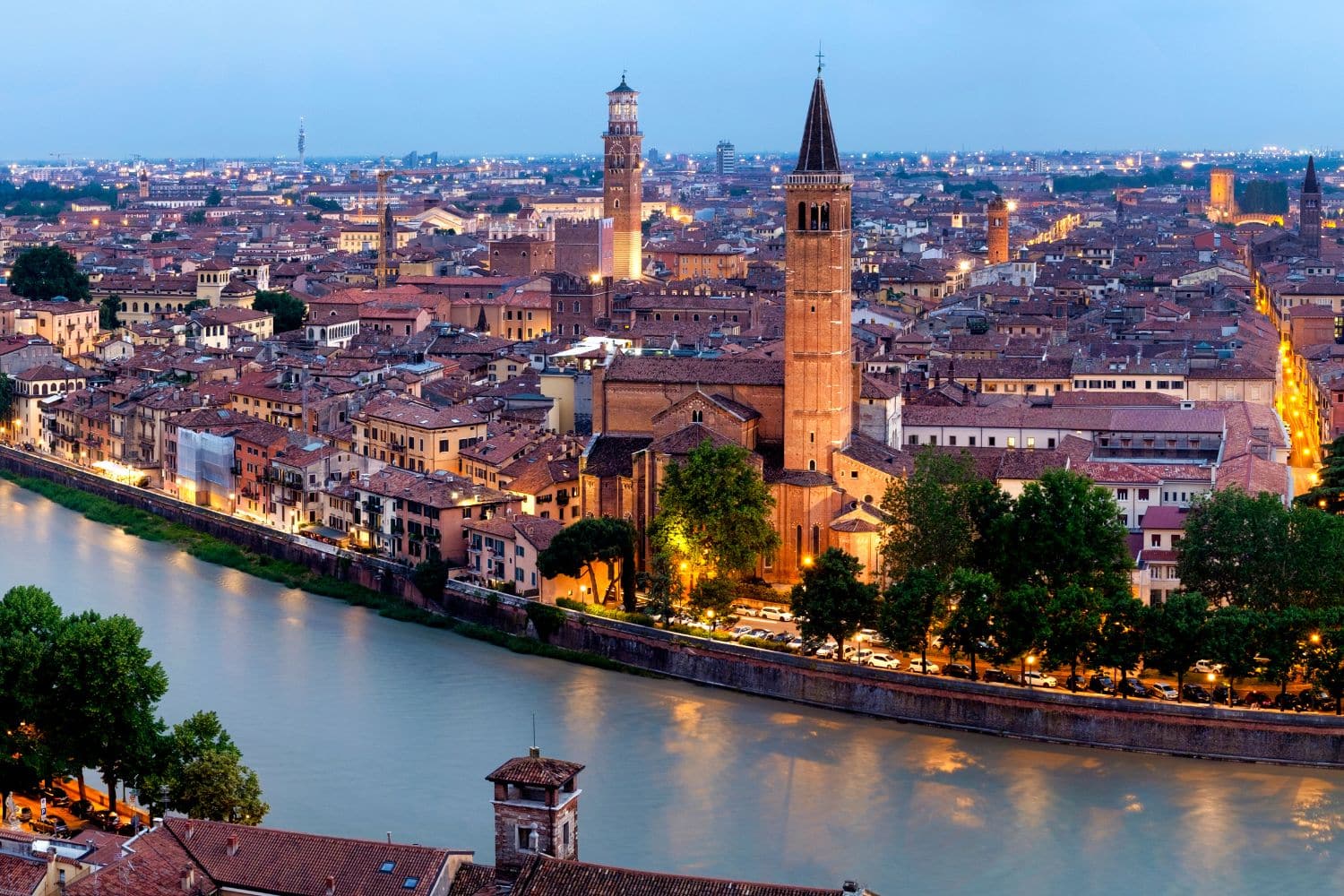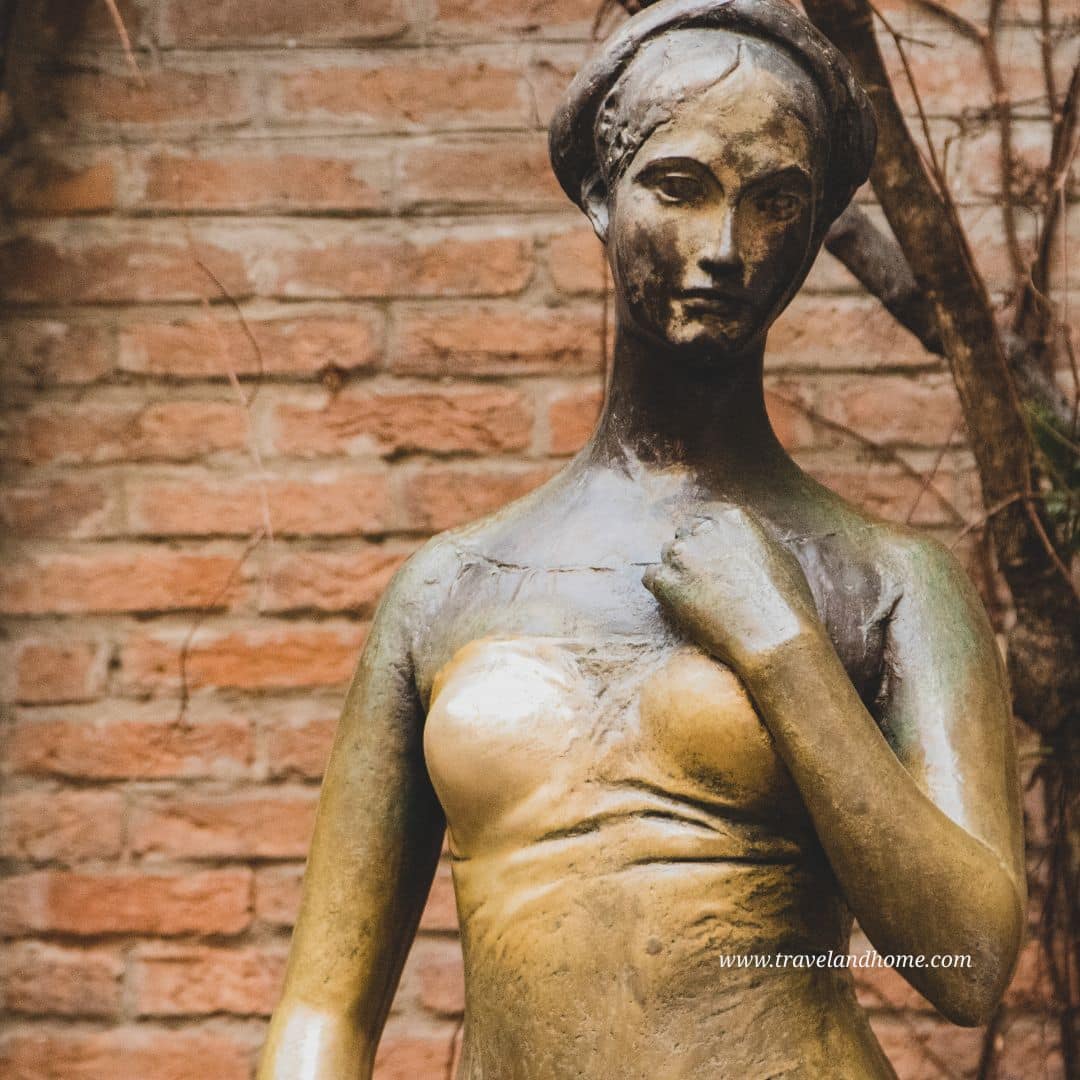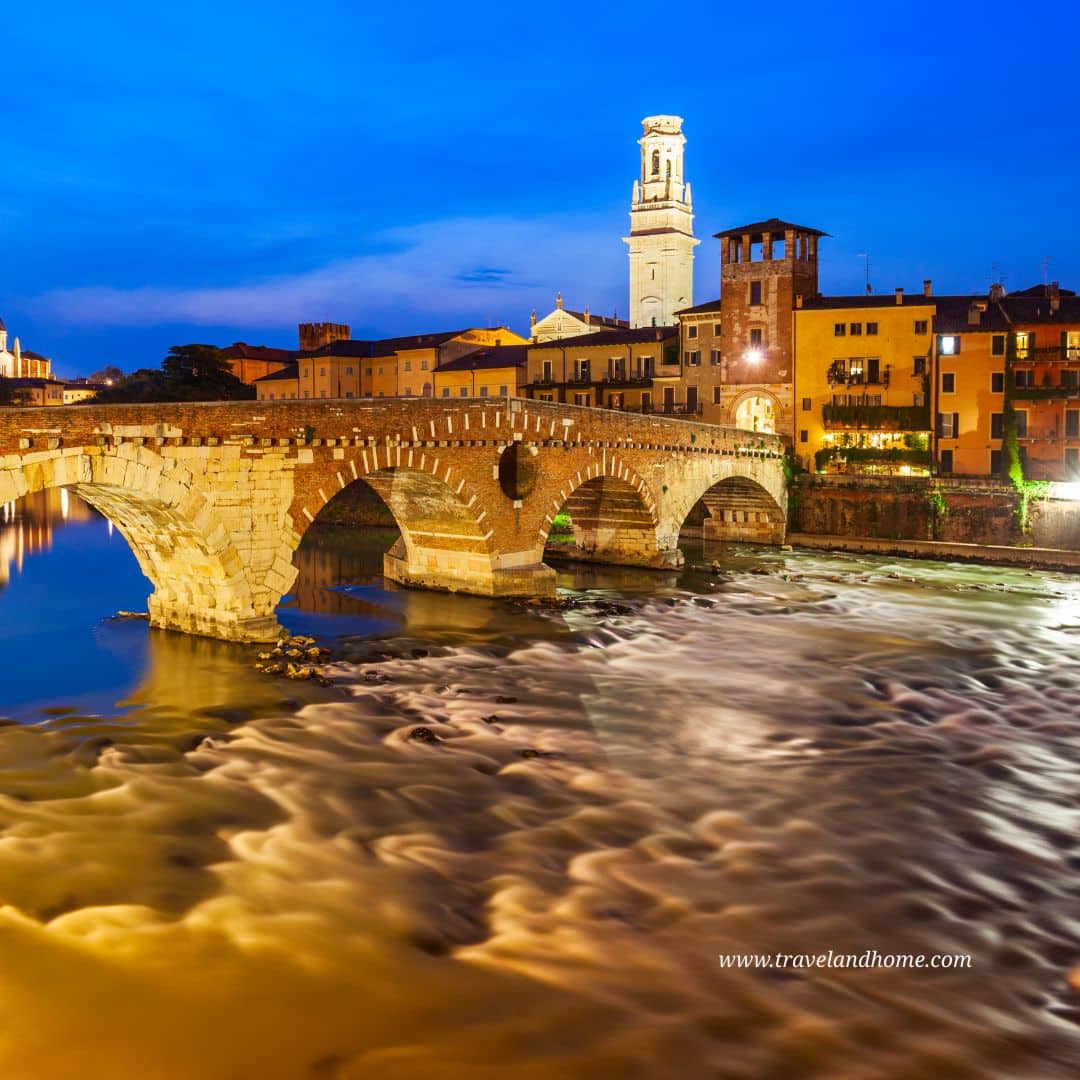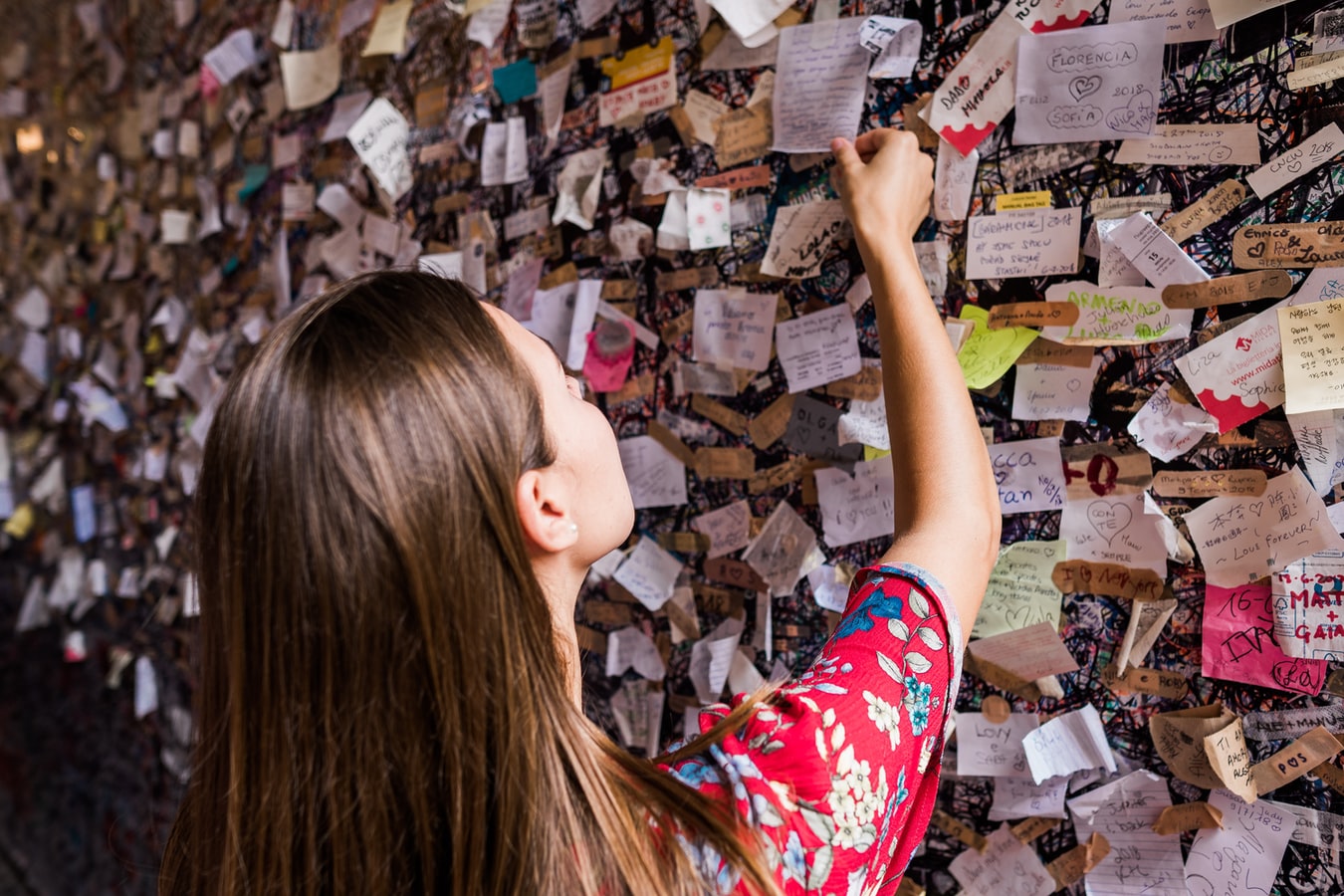Verona is one of Italy’s most walkable and romantic small cities. Often overshadowed by Venice and Milan, it’s packed with charm, easy to explore in a day or two, and gives you a perfect mix of views, food, and atmosphere. Here’s how to get the most out of your visit. Let’s look at the Top 7 Things to Do in Verona and get some extra travel tips, walking plans and more…

Climb Torre dei Lamberti for the Best View in Verona.
Start your visit by going up the 84-meter-high Torre dei Lamberti. You’ll get a bird’s-eye view of Verona’s rooftops, church towers, and distant hills. There’s an elevator if you don’t want to climb all the way. For more info, check out their website: TorredeiLamberti
Yes, it’s Roman. Yes, it’s old. But what makes Verona’s Arena truly special is how alive it still feels. You can walk inside, climb the worn stone steps, and sit where spectators sat 2,000 years ago. If you time it right, go just before sunset — the golden light floods in through the arches and makes the whole place glow.
Tip: In summer, they host open-air operas here. Even if you’re not an opera fan, the experience is unforgettable.

You can’t come to Verona and skip Juliet’s House, even if it’s crowded. Go early in the morning or late in the afternoon when it’s quieter. Touch the bronze statue for luck, read the love notes stuck to the wall, and take in the atmosphere of people hoping, remembering, dreaming.
Reality check: It’s a tourist trap, but a beautiful one. Don’t stay long — just soak it in and move on.
At Juliet’s House in Verona, there’s a bronze statue of Juliet in the courtyard. Tourists from all over the world pose for a photo with her — and over the years, rubbing her right breast has somehow become a “tradition.” People believe it brings good luck in love.
It’s not based on any historic fact or Shakespearean detail — just a modern habit that stuck. The statue has had to be replaced before because of the damage from millions of hands over time.
So when you see everyone reaching out to touch Juliet’s statue — that’s why. It’s not respectful, but it’s become part of the chaotic tourist scene.
This is the bridge you’ve seen in postcards — a Roman arch bridge with views that stretch all the way to Castel San Pietro. Walk across slowly. Look left, then right. The reflection of the old town in the river is one of the most romantic scenes in Italy.
Tip: Cross the bridge and head up to Castel San Pietro for the best viewpoint in the city.
For the best panoramic view of Verona, you’ve got two options: take the stairs (200+ steps) or hop on the funicular. Either way, you’ll reach a peaceful hilltop with sweeping views over the rooftops, the river, and all the warm tones of the city. Bring a snack and stay a while.
Go just before sunset — you’ll thank me.
This square is the heart of Verona. Colorful buildings, painted facades, a daily market, and café tables spilling onto the cobblestones. Stop for an Aperol spritz, enjoy the street performers, and look up — every building tells its own story.
Tip: Don’t eat at the tourist restaurants here. Drink your spritz, then walk two blocks for dinner.

Wander away from the main streets and you’ll find what Verona does best: silence, shade, and little details. Open gates that lead to ivy-covered walls. Flower boxes overflowing in alleys where nobody goes. It’s the part of Verona you can’t plan — but it’s the part you’ll remember.
These quiet corners are where your best photos will happen.
Sant’Anastasia is a very beautiful church of the Dominican Order, which opened it’s doors in 1290, and was built in Italian Gothic style. It is located near the Ponte Pietra. Walking inside is a real jaw-dropping moment.
Where: Piazza S.Anastasia, 37121 Verona VR, Italy
ALSO DISCOVER:
The Church of Saint Fermo – A monastic architecture: from the Benedictines to the Franciscans.


Read more about Verona and why you should visit this beautiful place, including travel tips: Read more >>>
These spots are picture-perfect and easy to add to your itinerary.
A peaceful Renaissance garden with cypress-lined paths, fountains, and panoramic city views from the top. Bring your camera.
One of Verona’s most photogenic streets. Arched walkways, hanging ivy, and a quiet café or two make this a dream for photos.
Elegant and calm. Less crowded than Piazza delle Erbe, with statues and cafés tucked under porticoes.
Skip tourist menus. Head into side streets and look for tiny osterias with handwritten menus. Order bigoli pasta, gnocchi with Monte Veronese cheese, and a glass of Amarone.
Where to go: Try Osteria al Duca, or cross the river for Trattoria Pane e Vino.
Just a short drive from Verona, Villa Mosconi Bertani is a stunning 18th-century wine estate surrounded by rolling vineyards. Touring the estate gives you a close-up look at the traditional winemaking process. The tasting room serves their famous Amarone, Valpolicella, and Recioto wines, all full-bodied and rich in flavor. The villa’s elegant architecture and peaceful gardens make this more than just a wine stop—it’s a full sensory experience.
Tip: Book your tour in advance, especially during the harvest season in September and October.

You can book all these activities easily online in advance:
Book via Viator or Book via GetYourGuide like we do, and skip the endless long lines.

Getting Around: Walk. Everything is close.
Best Time to Visit: Spring and early autumn (April–May or September–October) for mild weather and fewer tourists.
Language: Italian, but many speak English.
How Long to Stay: 1–2 nights is perfect.
Where to Stay: Choose a small boutique hotel or guesthouse inside the old city walls.
Start: Piazza Bra (Verona Arena)
Begin your journey in Verona’s largest square, home to the majestic 1st-century Roman Arena. Walk the perimeter to take in its scale and presence. Step inside if you have time — the views from the upper tiers are worth it.
Walk Via Roma to Castelvecchio and Scaligero Bridge
Follow Via Roma toward Castelvecchio, a medieval fortress beside the river. Cross the red-brick Ponte Scaligero for sweeping views of the Adige and Verona’s skyline.
Continue along Corso Cavour to Porta Borsari
Stroll along Corso Cavour to find the Arco dei Gavi and Porta Borsari — Verona’s ancient Roman gate that once marked the entrance to the city.
Arrive at Piazza dei Signori and the Scaliger Tombs
Reach Piazza dei Signori, a refined square framed by historic buildings and watched over by a statue of Dante. Nearby, the Scaliger Tombs add gothic drama — striking, ornate, and worth a short visit.
Enter Piazza delle Erbe
Just around the corner lies Piazza delle Erbe, Verona’s most atmospheric square. Stop for a coffee or aperitivo and enjoy the painted facades, market stalls, and the medieval tower rising above.
Climb Torre dei Lamberti (Optional)
If you’re up for it, head up Torre dei Lamberti — by stairs or elevator — for a bird’s-eye view over the rooftops and squares below.
End at Juliet’s House and Balcony
Finish the day with a short walk to Juliet’s House on Via Cappello. It gets busy, but even just a few quiet minutes early or late in the day can make this stop feel special.
Day 1 takeaway: A scenic and balanced route through Verona’s historical core. Expect a blend of Roman ruins, medieval architecture, Shakespearean drama, and lively piazzas.
🎒 Travel Tip(s):
Look for free cancellation options: Some hotels offer free cancellation up until a certain date. Booking accommodations with free cancellation can provide flexibility in case your plans change.
Check the map view: Booking.com has a map view feature that shows the location of hotels. This can help you identify accommodations in areas that are both desirable and affordable.
Day 1: Piazza Bra – Castelvecchio / Ponte Scaligero – Porta Borsari – Piazza dei Signori – Scaliger Tombs – Piazza della Erbe – Torre del Lamberti – Juliet’s House.
Day 2: Ponte Pietra – Castel San Pietro – Cathedral – Santa Anastasia – Hidden Courtyards – Piazza Erbe or Via Mazzini
Begin at Ponte Pietra
Start the morning at Ponte Pietra, Verona’s oldest bridge. Pause to take in the river views and the gentle curve of the Adige.
Climb to Castel San Pietro
Take the funicular or walk the stairs up to Castel San Pietro. This is the best panoramic viewpoint in the city — rooftops, towers, the winding river, all bathed in morning or golden hour light.
Walk down toward the Cathedral and Basilica di Santa Anastasia
Make your way back into the city via the Duomo (Verona Cathedral) and Basilica di Santa Anastasia — two beautiful churches that offer a calm retreat and impressive interiors.
Explore Verona’s Hidden Courtyards
Now it’s time to wander. Step off the main roads into side streets and courtyards. Look for ivy-covered walls, quiet fountains, or empty benches. These hidden spots are where Verona’s magic comes alive.
Return via Piazza delle Erbe or Via Mazzini
Finish your day with a final stroll through the city center. Either head back to Piazza delle Erbe or take Via Mazzini if you’d like to browse a few boutique shops along the way.
TRAVEL TIP : Consider buying the Verona Card — it includes entry to major sites and saves time at ticket lines.

How about a road trip from Verona to Limone sul Garda (lovely Lake Garda in Italy)? Read more >>>


Verona doesn’t try to impress like Venice or Milan. It charms you quietly—with its streets, its stories, and the golden light bouncing off old stone. It’s a city you don’t just visit—you feel it… and there are far more than just a top 7 or top 10 Things to Do in Verona…